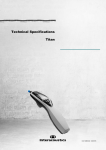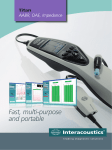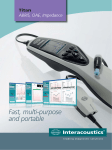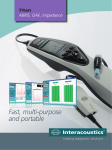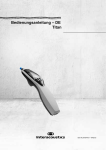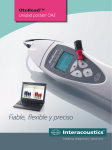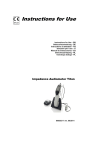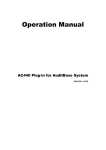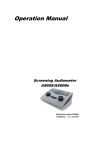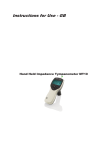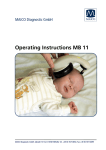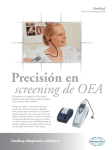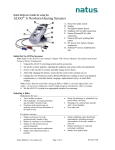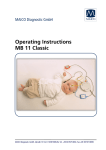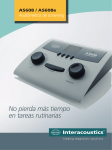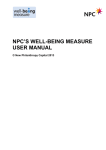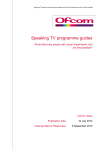Download Technical Specifications Titan
Transcript
Technical Specifications Titan Item No. 8100759 – ver. 04/2013 Titan - Technical Specifications Page 1 General Technical Specification Titan Hardware – Technical Specifications Medical CE-mark: Standards: Cradle Battery Operation environment: The CE-mark indicates that Interacoustics A/S meets the requirements of Annex II of the Medical Device Directive 93/42/EEC. Approval of the quality system is made by TÜV – identification no0123 Safety: IEC 60601-1, Internally powered, Type B and BF applied parts EMC: IEC 60601-1-2 Impedance: IEC 60645-5/ANSI S3.39, Type 1 Test Signal: IEC 60645-1/ANSI S3.6 , IEC 60645-3 OAE: IEC 60645-6 2009, Type 2 Otoacoustic emissions ABR: IEC 60645-7 2009, Type 2 Safety: IEC 60601-1, Class II Power Astrodyne ASA30M-0301 or UE24WCP Mains voltages and 100 – 240 VAC, 47 – 63 Hz frequencies: Consumption: 0.8 – 0.4 A Use only: Temperature: Relative Humidity: Ambient Pressure: Warm-up Time: Storing/handling: Transport: NP120 or CGA103450 15 – 35 C 30 – 90% 98kPa – 104kPa 0 seconds Temperatures below 0C and above 50C may cause permanent damage to the instrument and its accessories. Temperature: Rel. Humidity: -20 – 50 C 10 – 95% Impedance Measuring System Probe tone: Frequency: Level: Air pressure: Control: Indicator: Range: Pressure limitation: Pressure change rate: Compliance: Range: Test types: Tympanometry Indicators: Eustachian tube function 1 – Non perforated eardrum Eustachian tube function 2 – Perforated eardrum Eustachian tube function 3 – Patulous Eustachian tube Graphical display Memory: Tympanometry: Classic tympanometry: 226 Hz, 678 Hz, 800 Hz, 1000 Hz; pure tones; AGC controlled to protect for loud probe tone stimuli in small ear canals. WBT: 226 Hz – 8000 Hz broadband stimulus. 226 Hz: 85 dB SPL (≈ 69 dB HL) WBT: 96 dB peSPL (infant) / 100 dB peSPL (adult). (100 dB peSPL ≈ 65 dB nHL) Automatic. Measured value is displayed on the graphical display. -600 to +300 daPa. -750 daPa and +550 daPa. Minimum, medium, maximum or automatic with minimum speed at compliance peak. Selectable in the setup. 0.1 to 8.0 ml at 226 Hz probe tone (Ear volume: 0.1 to 8.0 ml) and 0.1 to 15 mmho at 678, 800 and 1000 Hz probe tone. Automatic, where the start and stop pressure can be userprogrammed in the setup function. Manual control of all functions. Williams test Toynbee test Continuous sensitive impedance measurement for 30 up to 150 s. Compliance is indicated as ml and pressure as daPa. In PC controlled mode admittance, susceptance and conductance can be printed. Stimulus level is indicated as dB Hearing Level. 1 curve per ear per tympanometry test. 3 curves per ear per Titan - Technical Specifications Page 2 Eustachian tube function test. And theoretically an infinite number of tests per protocol. There is no deviation between static and dynamic mode. Reflex Functions Signal sources: Outputs: Tone - Contra, Reflex: Tone - Ipsi, Reflex: NB noise - Contra, Reflex: NB noise - Ipsi, Reflex: Noise - Contra, Reflex: Noise - Ipsi, Reflex: Contra Earphone: Ipsi Earphone: Test types: Air: Manual Reflex Automated Reflex Reflex Decay Reflex latency 250, 500, 1000, 2000, 3000, 4000, 6000, 8000 Hz. 500, 1000, 2000, 3000, 4000 Hz. 250, 500, 1000, 2000, 3000, 4000, 6000, 8000 Hz. 1000, 2000, 3000, 4000 Hz. Wide Band, High Pass, Low Pass. Wide Band, High Pass, Low Pass. TDH39 earphone, DD45 earphone, CIR55 insert and/or EARtone 3A insert for Reflex measurements. Probe earphone incorporated in the probe system for Reflex measurements. Connection of the air system to the probe. Manual control of all functions. Automatic reflexes: Single intensities Reflex growth Automatic, 10 dB above threshold and manually controlled with stimulus durations of 10 to 30 s. Automated, first 300 ms from stimulus start. ABR Infant Screening Preamplifier Electrical Impedance measurement Stimulus One Channel: Gain: Frequency response: Noise: CMR Ratio: Max input offset voltage: Input impedance: Power from main unit: Measurement frequency: Waveform: Measurement current: Range: Stimuli: Stimulus rate: Transducers: (Calibrated to Standards) Recording Channels: Level: Bandwidth: Analysis time: A/D resolution: Artifact reject system: Display Algorithmic Sensitivity Algorithmic Specificity CE-Chirp: CE-Chirp: 3 electrodes. 50 cm Switchable: Software will automatically switch mastoid and ground if mastoid montage is used. So the user does not need to replace electrode during testing. 64 dB 0,5 - 5000 Hz <25 nV/√Hz >90 dB. 2.5 V 10 MΩ/ 170 pF Isolated power supply 33 Hz Rectangular 11.25 μA 0.5 kΩ – 25 kΩ ± 10 % Click range (200 Hz -11 kHz) CE-Chirp® range (200 Hz – 11 kHz) HiLo CE-Chirp® range (Lo – up to 1.5 kHz) & (Hi – above 1.5 kHz) 90 Hz EARTone ABR insert phone EARTone ABR for EarCup TDH 39 or DD45 head phone (Static force: 4,5N ± 0,5N IOW Probe 2 30 dB nHL, 35 dB nHL, 40 dB nHL 22.05 kHz 1-10 min or Residual noise 5-80 nV 24 bit Rejection level (Peak, Min RMS, Max RMS) & Clipping (Saturation) Stimulus level and type, Bar and Graph view Basic and advanced view 99.9% > 96% Titan - Technical Specifications Page 3 DPOAE Stimulus Frequency range: Nominal frequency: Frequency step: Level: Level Step: Transducer: Recording Analysis time: A/D Resolution: Artifact rejection system: Stimulus tolerance: SNR criteria: Probe check window: DP-response window: Residual noise: Display General display gain: Display: Titan IOW probe: Probe specifications Other Test Pressure: 500 to 10000 Hz f2 25 Hz 30 to 80 dB SPL (75 dB SPL for 6kHz and 65 dB SPL for 8kHz to 10kHz) 1 dB IOW Probe auto detection, auto calibrated Minimum 2 seconds to unlimited time 24 bit, 5.38 Hz resolution -30 to +30 dB SPL or off Adjustable between 1 and 10 dB Adjustable between 3 and 25 dB 256 points frequency response of the ear canal due to a click stimulus. 4096 points frequency response A RMS average measurement in the DP-bin frequency area (26 bins at frequencies < 2500 Hz & 60 bins ≥ 2500 Hz). Applicable during testing Stimulus level and type, Bar and Graph view IMP, DPOAE, TEOAE and ABRIS capable Replaceable probe tip Ambient pressure. Tympanic peak pressure. TEOAE Stimulus Recording Display Frequency range: Frequency step: Stimulus type: Level: Level step: Click rate: Stimulus tolerance: Transducer: Analysis time: A/D Resolution: Artifact rejection system: SNR criteria: TE criteria: Stimulus time window: Probe check window: Time recording window: Wave reproducibility window: Freq. response window: Other information: Probe specifications Other Test Pressure: Titan IOW probe: 500 to 5500 Hz 1 Hz (Custom bands) Non-Linear and Linear (according to IEC 60645-3) 30 to 90 dB peSPL, peak to peak calibrated, AGC controlled 1 dB 43 – 100 Hz Adjustable between 1 and 3 dB IOW Probe auto detection, auto calibrated 1 second to unlimited time 24 bit 0 to +60 dB SPL or off Adjustable between 5 and 25 dB Band SNR, No. of Sweeps, Test time, Min Total OAE, Min Reproducibility - adjustable for use as test criteria 128 points instant recording of first click in sequence of clicks 256 points frequency response of the ear canal recorded click stimulus 3 – 23 msec (max). A and B buffer time-samples @ sampling rate 11025 Hz Adjustable inside the recording window 256 points frequency response, bin spacing 43 Hz In ear status (active during test), Noise level, Tympanic peak pressure Basic and Advanced view, FFT view, Test Summary view IMP, DPOAE TEOAE and ABRIS capable Replaceable probe tip Ambient pressure or tympanic peak pressure found in IMP module Titan - Technical Specifications Page 4 General PC control: USB: Memory: Thermal printer (Optional): Type: Paper width: Printing time: Dimensions Titan Weight ABR/OAE/IMP PreAmp shoulder box weight ABR/OAE/IMP PreAmp shoulder box Dimensions OAE/IMP shoulder box weight OAE/IMP shoulder box Dimensions Input/output for computer communication. Titan can be fully operated from a PC. The measurements can then be followed on the PC screen. Data can be sent to and saved on the PC and stored in OtoAccess™. See separate section in Service Manual for programming details. Theoretically, an infinite amount of test results can be stored on the PC. The Titan hand held unit is delivered with a 1 GB memory card, enough for storing more than a quarter of a million tests. Thermal (Bluetooth) printer with recording paper in rolls. Print on command through Bluetooth communication and through serial RS232. 57.5 ± 0.5 mm on thermal printer Printing time depends on the size of the used protocol. For 2 tympanograms and 8 reflexes the thermal printer uses approximately 6s. 6 x 6 x 28 cm / 2.4 x2.4 x11 inches 360 g / 0.8 lbs 120 g / 0.26 lbs 10.2 x 6.8 x 2.6 cm / 4 x 2.7 x 1 inches 64 g / 0.14lbs 6.5 x 3.5 x 1.8 cm / 2.6 x 1.4 x 0.7 inches Titan - Technical Specifications Page 5 Table 1: Frequencies and Intensity Ranges for IMP440 Titan Maximums IMP Center Freq. [Hz] 125 250 500 750 1000 1500 2000 3000 4000 6000 8000 10000 WB LP HP TDH39 Reading Tone [dB HL] 80 100 120 120 120 120 120 120 120 120 105 CIR55 Reading NB Tone [dB HL] [dB HL] 65 85 85 100 100 110 105 110 105 115 105 115 105 115 105 115 105 110 100 95 95 80 EARtone 3A Reading NB Tone NB [dB HL] [dB HL] [dB HL] 70 100 85 85 110 100 100 115 105 105 120 110 105 120 110 105 120 110 105 120 110 105 120 110 100 120 105 95 105 100 85 90 85 IOW IPSI Reading Tone NB [dB HL] [dB HL] 70 60 85 75 100 85 100 85 105 90 110 90 105 90 95 90 100 85 85 80 80 75 DD45 Reading Tone [dB HL] 80 100 115 120 120 115 115 125 115 110 105 NB [dB HL] 65 85 100 105 105 100 100 105 105 90 95 - 120 120 120 120 120 120 - - 125 120 130 - - 120 120 120 105 110 105 Table 2: Frequencies and Intensity Ranges for DPOAE440 Titan Maximums DPOAE Center Freq. [Hz] 500 750 1000 1500 2000 3000 4000 6000 8000 10000 IOW IPSI Reading IOW ch2 Reading Tone [dB SPL] Tone [dB SPL] 80 80 80 80 80 80 80 75 65 65 80 80 80 80 80 80 80 75 65 65 Titan Maximums TEOAE Maximum TEOAE Click Intensity: 90 dB peSPL Titan Maximums ABRIS Maximum ABRIS levels for Click and CE-Chirp stimuli are limited to 30, 35 & 40 dBnHL for all transducers. Titan - Technical Specifications Page 6 Specification of input/output connections Inputs Patient response Connector type Jack, 3,5mm 4pole Electrical properties Handheld switch: Pin 1: GND Pin 2: Signal Pin 3: Future use I/O Pin 4: Future use I/O 3V through 10K is forced to ground when activated Outputs: Phones, Left/ Right Jack, 3,5mm 4pole Up to 3V rms. by 10 load 8 Pin 3: Phones, Contralateral Up to 3V rms. by 10 load 8 Transducer Data I/O: USB Voltage: Min. load impedance: Pin 1: CH1 GND Pin 2: CH1 OUT (left) Pin 3: CH2 OUT (right) Pin 4: CH1 GND Jack, 3,5mm 4- Voltage: pole Min. load impedance: Pin 1: CH1 GND Pin 2: CH1 OUT (left) Pin 3: CH2 OUT (right) Pin 4: CH1 GND IA proprietary, 12- Pin 1: pole Pin 2: Pin 3: Pin 4: Pin 5: Pin 6: Pin 7: Pin 8: Pin 9: Pin 10: Pin 11: Pin 12: USB type”B” CH1 out CH1 GND DGND GND A / GND Microphone Microphone – input / Analog balanced in Microphone + input / Analog balanced in Power supply +3/+5V CH2 out CH2 GND I2C CLK I2C DATA I2C Interrupt USB port for communication Calibration Properties Calibrated Transducers: Accuracy: Telephonics TDH39 with a static force of 4.5N 0.5N and/or EARtone 3A and/or CIR55 insert phone Probe system: Ipsilateral Earphone: is integrated in the probe system Probe frequency transmitter and receiver and pressure transducer is integrated in the probe system General Generally the instrument is made and calibrated to be within and better than the tolerances required in the specified standards: Reflex Frequencies: 1% Contralateral Reflex and 3 dB for 250 to 4000Hz and 5 dB for 6000 to Audiometer Tone Levels: 8000Hz Ipsilateral Reflex Tone 5 dB for 500 to 2000Hz and +5/-10 dB for 3000 to Levels: 4000Hz DPOAE Levels: 1.5 dB for 1000 to 4000Hz and 3 dB outside range Pressure measurement : 5% or 10 daPa, whichever is greater Compliance measurement: 5% or 0.1 ml, whichever is greater Contralateral Earphone: Titan - Technical Specifications Page 7 Impedance Calibration Properties Probe tone Frequencies: Level: Compliance Pressure Distortion: Range: Temperature dependence: Pressure dependence: Reflex sensitivity: Temporal reflex characteristics: Range: Safety limits: 226 Hz 1%, 678 Hz 1%, 800 Hz 1%, 1000 Hz 1% 85 dB SPL 1.5 dB measured in an IEC 60318-5 acoustic coupler. The level is constant for all volumes in the measurement range. Max 1% THD 0.1 to 8.0 ml -0.003 ml/C -0.00020 ml/daPa 0.001 ml is the lowest detectable volume change Initial latency = 35 ms (5 ms) Rise time = 45 ms (5 ms) Terminal latency = 35 ms (5 ms) Fall time = 45 ms (5 ms) Overshoot = max. 1% Undershoot = max 1% Values between -600 to +300 daPa can be selected in the setup. -750 daPa and +550 daPa, 50 daPa Reflex Calibration Standards and Spectral Properties: General Specifications for stimulus and audiometer signals are made to follow IEC 60645-5 Contralateral Earphone Pure tone: Wide Band noise (WB): Spectral properties: ISO 389-1 for TDH39 and ISO 389-2 for CIR 55. Interacoustics Standard As “Broad band noise” specified in IEC 60645-5, but with 500 Hz as lower cut-off frequency. Low Pass noise (LP): Interacoustics Standard Uniform from 500 Hz to 1600 Hz, 5 dB re. 1000 Hz Spectral properties: level High Pass noise (HP): Interacoustics Standard Uniform from 1600 Hz to 10KHz, 5 dB re. 1000 Hz Spectral properties: level Ipsilateral Earphone Pure tone: Interacoustics Standard. Wide Band noise (WB): Interacoustics Standard As “Broad band noise” specified in IEC 60645-5, but Spectral properties: with 500 Hz as lower cut-off frequency. Low Pass noise (LP): Interacoustics Standard Uniform from 500 Hz to 1600 Hz, 10 dB re. 1000 Hz Spectral properties: level High Pass noise (HP): Interacoustics Standard Uniform from 1600 Hz to 4000 Hz, 10 dB re. 1000 Hz Spectral properties: level General about levels: The actual sound pressure level at the eardrum will depend on the volume of the ear. See Table 2 for details. The risk of artifacts at higher stimulus levels in reflex measurements are minor and will not activate the reflex detection system Titan - Technical Specifications Page 8 Table 3: Reference Values for Stimulus Calibration Freq. Reference values for stimulus calibration Variation of Ipsi stimulus levels for different volumes of the ear canal Relative to the calibration performed on an IEC 126 coupler [dB] [dB re. 20 µPa] 26 14 5.5 0 2 3 3.5 5.5 2 0 -5 -7 -8 26 14 5.5 0 2 3 3.5 5.5 2 0 -5 -7 -8 47.5 27 13 6 8 8 8 9 20.5 12 41 24.5 9.5 6.5 5 12 11 3.5 3 -5 -8 -6 -10 -5 -7 -8 IOW NB Probe Stimulus NB Correction Values (except IOW probe) 43.5 4 26.5 4 17 4 10.5 6 12 6 11 6 11 6 8 5 5.5 5 -0.5 5 peRETSPL 27.5 31.5 26 32 CEChirp 26.5 26.5 25.5 27.5 CELow Chirp 28 31 28 32 CEHigh Chirp 35 32.5 28 Click 30.5 *All figures in bold are Interacoustics Standard values. 1 ml ISO 389-4 (ISO 8798) 45 25.5 11.5 7 6.5 9 10 9.5 15.5 13 -8 -6 -10 DD45 IOW Probe Interacoustics Standard 125 250 500 1000 1500 2000 3000 4000 6000 8000 Interacoustics Standard TDH39 Interacoustics Standard ISO 389-2 (Interacoustics Standard) [Hz] EARtone CIR55 3A / ABR WB LP HP ISO 382-2 (Interacoustics Standard) ISO 389-1 (Interacoustics Standard) RETSPL 0.5 ml Sound attenuation values for TDH39 earphones using MX41/AR or PN51 cushion [dB] 9.7 9.7 5.3 5.3 11.7 -0.8 -1.6 3.9 -0.5 -0.8 7.5 8.0 3.9 3.2 3.6 1.4 3 5 7 15 21 (1600 Hz) 26 31 (3150 Hz) 32 26 (6300 Hz) 24 Titan - Technical Specifications Page 9 Coupler Types used by Calibration IMP: TDH39 is calibrated using a 6cc acoustic coupler made in accordance to IEC 60318-3, Ipsilateral earphone and probe tone are calibrated using a 2cc acoustic coupler made in accordance to IEC 60318-5 ABRIS: Probe and insert stimuli are calibrated in SPL values using an ear simulator coupler made in accordance to IEC 60318-4. Headphones (TDH39 and DD45) stimuli are calibrated in SPL values using an artificial ear coupler according to IEC 60318-1. DPOAE: Probe stimuli L1 and L2 are calibrated in SPL values using an ear simulator coupler made in accordance to IEC 60318-4. TEOAE: Probe stimuli are calibrated in peSPL values using an ear simulator coupler made in accordance to IEC 60318-4. General about Specifications Interacoustics continuously strives to improve its products and their performance. Therefore the specifications can be subject to change without notice. The performance and specifications of the instrument can only be guaranteed if it is subject to a technical maintenance at least once a year. This should be carried out by a workshop authorized by Interacoustics. Interacoustics puts diagrams and service manuals at the disposal of authorized service companies. Enquiries about representatives and products may be sent to: Interacoustics A/S Phone: +45 63713555 Drejervaenget 8 Fax: +45 63713522 DK 5610 Assens E-mail: [email protected] Denmark http: www.interacoustics.com Titan - Technical Specifications Page 10 Included and Optional Parts IMP440 Included parts: Titan handheld unit with basic probe Power supply (with converter) BET55 Ear tips and box Lithium Battery 4 cavities (0.2, 0.5, 2 and 5cc) Titan PC suite with IMP440 Instructions for Use TCB Carrying Bag Included parts with diagnostic & clinical versions: Cradle Clinical probe extension CIR55 contra insert headset OtoAccess™ database Optional parts: Short probe extension Thermal printer AB1310/AB1310 Bluetooth DD45C contra cup headset EARtone 3A insert headset for contra Cradle Clinical probe extension OtoAccess™ database WBT calibration kit DPOAE440 Included parts: Titan handheld unit with basic probe Cradle Power supply (with converter) Clinical probe extension BET55 Ear tips and box Lithium Battery 4 cavities (0.2, 0.5, 2 and 5cc) Titan PC suite with DPOAE440 OtoAccess™ database USB cable, USB adaptor Instructions for Use TCB Carrying Bag Included parts with screener version: Eartip 3-5mm flanged (25 pcs.) Eartip 4-7mm flanged (25 pcs.) Eartip 5-8mm flanged (25 pcs.) Optional parts: Short probe extension Thermal printer AB1310/AB1310 Bluetooth ABRIS440 Included parts: Titan handheld unit with basic probe Cradle Power supply (with converter) PreAmplifier w/clothing clip & neckstrap Montage stickers Short extension cable ETSE tab surface electrode cables Pinch style electrode cables Sanibel tab surface electrodes (36 pcs.) Sanibel snap surface electrodes (36 pcs.) SPG15 preparation gel Alcohol pads, Gauze swabs USB cable, USB adaptor BET55 Ear tips and box Eartip 3-5mm flanged (25 pcs.) Eartip 4-7mm flanged (25 pcs.) Eartip 5-8mm flanged (25 pcs.) Lithium Battery 4 cavities (0.2, 0.5, 2 and 5cc) Titan PC suite with ABRIS440 OtoAccess™ database Instructions for Use TCB Carrying Bag Optional parts: EARtone ABR stereo ID earphones EarTone EarCup stereo ID transducer Thermal printer AB1310/AB1310 Bluetooth TDH39 Stereo ID headset DD45 stereo ID headset TEOAE440 Included parts: Titan handheld unit with basic probe Cradle Power supply (with converter) Clinical probe extension BET55 Ear tips and box Lithium Battery 4 cavities (0.2, 0.5, 2 and 5cc) Titan PC suite with DPOAE440 OtoAccess™ database USB cable, USB adaptor Instructions for Use TCB Carrying Bag Included parts with screener version: Eartip 3-5mm flanged (25 pcs.) Eartip 4-7mm flanged (25 pcs.) Eartip 5-8mm flanged (25 pcs.) Optional parts: Short probe extension Thermal printer AB1310/AB1310 Bluetooth











